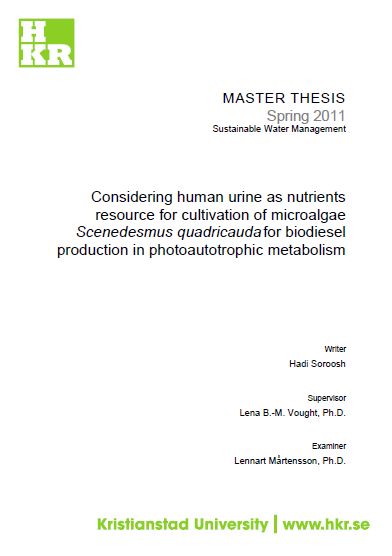Considering human urine as nutrients resource for cultivation of microalgae - Scenedesmus quadricauda for biodiesel production in photoautotrophic metabolism
Soroosh, H. (2011)

Published in: 2011
Publisher:
Master Thesis, Kristianstad University, Sweden
Author:
Soroosh, H.
Uploaded by:
SuSanA secretariat
Partner profile:
common upload
6613 Views
277 Downloads
Content - Summary
This study aims to illustrate the possibility of using human urine as an alternative to chemical fertilizer and municipal wastewater for the cultivation of microalgae, to produce third generation biodiesel. Human urine has been considered as alternative for other conventional nutrient resource because it is enriched with macro and micro nutrients. In addition, this alternative does not introduce side effects such as being unsustainable, algae contamination and predation with other microorganism available in sewage like chemical fertilizer or municipal wastewater traditionally does.
This study has tried to focus on first phase of microalgae biodiesel production which is to increase biomass in nutrients abundance. This is a prerequisite phase for lipid production and accumulation due to nutrients depletion or other sort of biological stresses. In this study, the growth rate of Scenedesmus quadricauda has been determined under standard culture (Bold solution) and urine with equivalent phosphorus concentration. The biomass production and chlorophyll generation were considered as indexes of primary production in phototrophic conditions.
In all the experiments, diluted human urine performed more efficiently compared to other solutions and is shown as being totally compatible for algae growth and production. The chlorophyll production up to 0.31 mg/L and biomass production up to 64 mg L-1 d-1 dry mass were achieved. On the other hand, Nitrogen/Phosphorus availability is not well proportioned to promote algal biomass production equally. While phosphorus uptake by algae is over 95%, nitrogen removal cannot reach over 32% in higher urine concentrations which cause high nitrogen levels prevent lipids accumulation due to nitrogen depletion. Urine-based cultures under high levels of phosphorus (as limiting factor) demonstrate growth prohibition in concentrations over 3.0 mg P/L content which can be caused by toxicity of high free ammonia concentrations.
Consequently, urine has recognized as reliable sustainable constitution for other nutrient resources for algal biomass production, but the nutrients levels should be manipulated in urine toward enhancing biodiesel production.
Also available for download below:
Conference paper from 2012:
COMPETITIVENESS OF HUMAN URINE FOR CULTIVATION OF MICROALGAE Scenedesmus quadricauda FOR BIODIESEL PRODUCTION
Bibliographic information
Soroosh, H. (2011). Considering human urine as nutrients resource for cultivation of microalgae - Scenedesmus quadricauda for biodiesel production in photoautotrophic metabolism. Master Thesis, Kristianstad University, Sweden
Filter tags
English Urine














